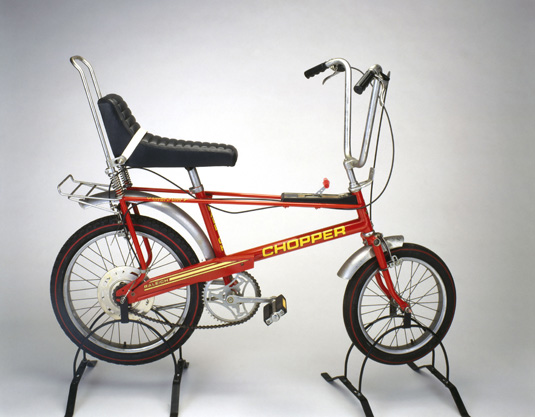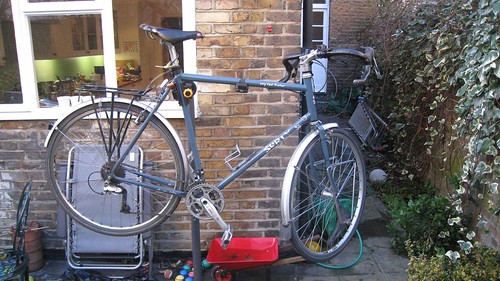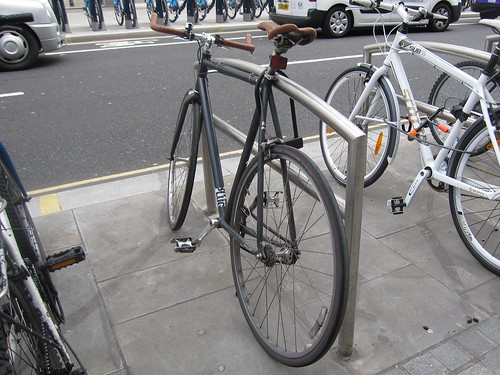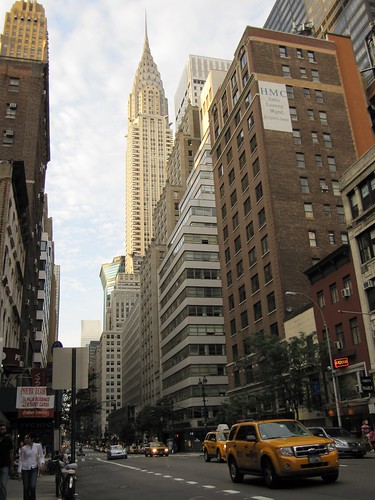As I wheeled my bike towards the junction of Reade Street Manhattan New York New York ,
after all, drives on the other side of the road from London
At its very worst, such fear can be self-reinforcing. At one
point yesterday evening, unsure both of the line I should be taking on the road
and the behaviour of a looming taxi driver, I dithered, wobbling about – and
succeeded in both irritating the driver and making myself feel more nervous
still. It’s when intimidated like that that I sometimes let drivers force me
too close to the side of the road, before passing aggressively and too close.
Nervousness over the close pass then makes things still worse.
 |
| The South Street bike lanes could seem scary - or romantically urban, depending on mood |
My moment of fear on Monday morning was not the first I’ve
experienced over riding my bike in heavy traffic. Unless my fears were so
well-founded I’m crushed tomorrow by a truck, it probably won’t be the last. Fear
is, at the very least, an understandable emotion for a person riding a light,
human-powered vehicle among big, heavy, fast-moving vehicles. It plays an even
more important role in the thinking about cycling of people who don’t do it. In
most countries with low cycling levels, non-cyclists give fears about safety as
their main reason for refraining. Safety worries are a popular excuse at least partly
because they sound less lame than admitting one’s lazy. But it’s also reasonable
to assume that fear is paralysing a fair proportion of potential riders out of
taking to the roads.
I didn’t, however, ditch my old hybrid for the subway. I
instead swung my leg over the saddle, headed off down Reade and was soon
enjoying a remarkably smooth and speedy ride by the Hudson River Greenway
towards my new office.
Regular readers of this blog will be aware that I am
impressed with human beings’ irrationality. They consistently let their emotional
instincts – the feeling emanating from the guts that I felt knotting on Monday –
dictate to higher brain centres.
People particularly consistently miscalculate the risks involved
in getting about. Many pedestrians, for example, feel themselves genuinely at
risk from cyclists. They vastly underestimate, meanwhile, the extent of the risks
motor vehicles present to them.
Yet human beings enjoy such long lives partly because they
also have some healthy fears – and strong instincts to avoid the biggest risks.
The trick, it seems to me, is to sift the warnings from the useful instinct from
the constraining voice of the irrational one.
It was after I narrowly avoided an inattentive car in London
The physical danger bothered me far less than what followed,
however. Surrounding motorists either shouted angrily at me for having stopped
and held them up or shouted mocking abuse over how I had reacted. They were
expressing the kind of unrestrained, uncivilised venom and cruelty that
surfaces in the worst kind of school playground. Having comprehensively failed
to handle such environments well as a child, I reverted to being the little boy
of nearly 40 years ago. I felt a pathetic, weak instinct to curl up in a ball
and weep. The personal cruelty and anger – which posed no real threat – had got
to me far more than the physical danger.
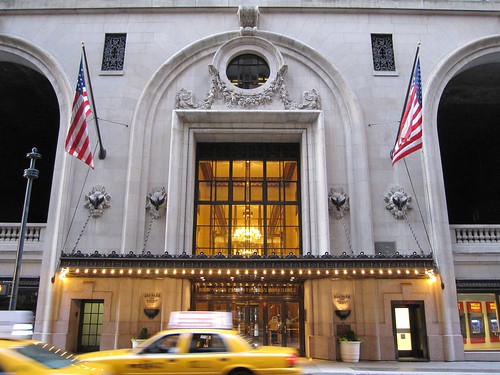 |
| Taxis rush past the New York Central Building: they're almost certainly not hurrying to the aid of a stricken cyclist, the Invisible Visible Man can confirm. |
Something similar was at work as I prepared to embark on my
current house-hunting expedition to New York –
and my forthcoming full-time move across the Atlantic .
The sheer venom of most of the comments accompanying any article about New York New York as a city seems still more irritated than London New York City
 |
| New York City's authorities seem, like so many city governments, to have only imperfectly grasped the point that cyclists need to ride their bikes on cycleways |
Yet I’ve been prepared to cope, I think, at least partly
because of past periods of deep, far
more rational nervousness. Having long boasted I had never been knocked off my
bike in London
My fear gradually distilled, however, into a habit of
looking still more carefully than before for signs of sudden, unexpected
movements. Even on apparently quiet roads, I now look far more than before over
my shoulder, scanning the road for the next motorist seeking to cut across my
path. It was at least partly because of those experiences I was able to spot,
and avoid, the Inattentive Turner of Tooting.
And, of course, if avoiding fearful situations were my main
priority, I wouldn’t be here in New
York London Budapest
The truth is that fear plays a part in the tingling
sensation one feels before embarking on something difficult and challenging –
whether a difficult bike ride, a new job or some new relationship. It’s the
risk of failure that creates the sense of intense alertness that makes them
enjoyable. It’s the feeling of having conquered the fears and the difficulties
that makes it satisfying to finish.
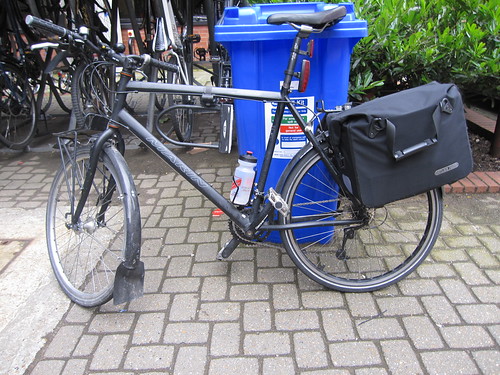 |
| The Invisible Visible Man's Marin Muirwoods before the Embarrassing Case of the Pedal Incompetence |
The 65 miles or so I’ve so far cycled around Manhattan and Brooklyn
certainly haven’t been trouble-free. It turned out, for example, that I’d
messed up screwing on and off the pedals on my old, spare bike when bringing it
on the ‘plane. A pedal fell off on Sunday in Prospect Heights New York Carroll
Gardens New York
 |
| The Manhattan Bridge: a rare chance to race subway trains |
But I’ve taken my old bike speeding in glorious sunlight up
by the Hudson River, looking over to New
Jersey Manhattan Bridge Manhattan
Those aren’t experiences I’ve enjoyed despite my fear. They’re not feats that
have required any special bravery to accomplish. But they’ve been ones that
have been all the more rewarding because I’ve overcome a slug of my own cowardice on the
way.
